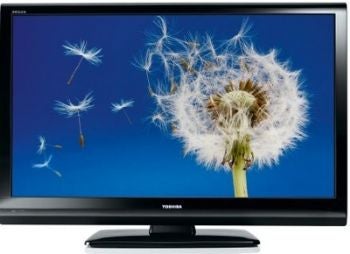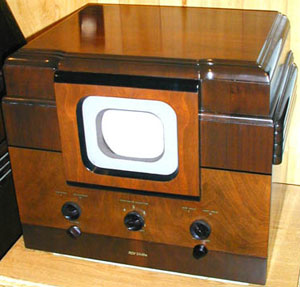TV has become a significant device in our households. Say what you will about the social implications, or the value (or lack thereof) of some programming, but the foothold of the television has continued to increase over th decades of its existence. The programming has evolved, and the technology has evolved.
Believe it or else, younguns, there was actually a time when a "big screen" was a 12" black & white in a console, receiving all four channels. Yup, only four - ABC, NBC, CBS and DuMont (which folded in 1956). Color would be brought to the television in 1953, but would not be common in households until the 1960's. UHF, cable, and satellite would increase the number of programming options. At the same time, companies were making bigger and better televisions. With the push for high definition, a few things would change.
The first thing that one notices in the difference between standard and high definition, is that high definition televisions (HDTV's) have a different shape. Instead of the 4:3 shape, they now have a wider format 16:9. Thus your old 27" television may be taller than your 32" HDTV. Another thing that one will notice is that the size is much different. No more bulky tube TV's. Personally, I tore a pectoral muscle in lifting a 32" tube television from the floor to its stand, yet I carried a 42" HDTV distances of yards. Another thing that should be noticed is the resolution. HDTV's have a much higher resolution than standard. This means you can fit more pixels into the same area, allowing for clearer pictures, and closer zooms. I will fall back to my NFL analogy from yesterday. Courtesy of the higher definition, a replay offical can see such things as if a player went out of bounds, or maintained control of a catch.
What's available, and what should you look for?
Three main types are on the market today, plasma, LCD and LED. Plasma rely on superheated gas to deliver their picture. They tend to be on the lower end of the cost spectrum, but have a tendency to run hot. They also aren't necessarily the most energy efficient products. LCD televisions use a liquid crystal display to create the image. These have the biggest share on the market, as far as manufacture and sale. LED televisions use light emitting diodes to convert the signal to image. These are very energy efficient and are fairly cool running, though they do tend to come with a premium price tag. As a fair warning, here, LED televisions also make use of LCD screens, however it's a matter of using the LED's instead of CCFL bulbs to create the image.
There are two other numbers that you will see in the advertising. First is a number, generally 720p, 1080i or 1080p. These refer to the resolution of the television. A quick, not-so-technical explanation is that these numbers represent one of the dimensions used to calculate the screen pixels. The higher the better, as a 1080p telesion can process about 2.1 million pixels per second, which is about 5x greater than that of the old standard definition set. The other number is the refresh rate. You will see this in Hertz. The scientific types out there will recognize that the Hertz measurement relates to a cycle, and the refresh rate is just that. For the non-technical, a good summary is "the higher the number, the faster it transmits changing images. There can be too much of a good thing, here, though. Some televisions with a very high refresh rate (240Hz, for instance) can cause some film shot at the old 24Hz rate to appear kind of like a "home movie". Some people pick up on this more than others. This should be a consideration when
At this point, I'd also like to point out that there are a number of 3D HDTVs on the market, as well. Building off the success of 3D movies in the past few years, 3D televisions started making their appearance on the market. They take advantage of the capabilities of the screens to produce a three dimensional image that can be viewed with special glasses. There are also 3D Blu-Ray players, (and discs) which are created to work specifically with these televisions. Two things to keep in mind here. First, you are going to be limited by your "weakest link". If you have a 3D blu-ray player, and a 3D copy of The Dark Knight Rises, but only a 720p LCD television, you will not see it in 3D. Likewise, a DVD copy of The Great Escape will not transform into 3D, with the TV and player. One other fairly important thing to consider is that some people have problems with 3D television or movies. Personally, I saw Avatar in 3D, and had a headache for three days afterward. I thought it was just the way my eyes work, but a friend with "perfect" eyes said he got a headache after 30 minutes of watching his friend's new 3D TV. Fortunately, stores like Best Buy and HH Gregg have demos of these televisions out for you to check out, and see how you like it. Not sure they want you sitting through an episode of The Simpsons, or Monday Night Football to decide, but you should be able to take all the time you need. After all, this will be your TV, and it needs to be the right match for you.
Now we come to the all important deciding point. Much like I did yesterday with blu-ray players, I am not going to come out and openly endorse one brand over all others. I've seen quality products from Toshiba, Magnavox, Samsung, Vizio, LG, Sony, Sharp, and Mitsubishi, amongst others. We have two Insignia models in the house that have not had any issues. I also have a Dynex (Best Buy's lower end) 22" with a DVD combo that serves double duty as a monitor with no issues in three years. "Off brands" or "store brands" may get you a lower price (Haier, Scepter, Dynex, Curtis, Apex,etc), but they may either be lacking in quality or dependability. This isn't to say that these brands are junk, but in some cases, you do get what you pay for. This same holds true to the higher end units: more expensive does not necessarily equal "better".
What size should you get? I know, "bigger is better", right? Not necessarily. To be fair, the change in screen shapes has altered the size of televisions. So, a 32" HDTV will be wider, but shorter than a 27" standard definition tube television (direct comparison of a 2003 Toshiba 27" stereo television vs a 2010 Toshiba LCD television shows the 27" being approximately 3" taller, though about a foot narrower - and a lot heavier) This means that you can get a bigger television in some of the same places (not counting cabinets with fixed-sized cubby holes. In addition, mounting brackets are available to put these lighter televisions on a wall. This can free up space formerly taken up by a bullky tube television, and stand.
It's best to assess your space first - where do you want to put this, how will you put it in, how much use will it get, what is the purpose of it? If you're looking to install a little television in a small kitchen, then maybe a 42" screen is excessive. If it's one that won't get a lot of use, then maybe it's better to go with a less expensive model. Most importantly, though it needs to fit (physically and within your budget). This 110" TV from JVC may exceed both. At about $5,000, the 92" screens from Mitsubishi & Sharp may be more "affordable" (relatively), but will they fit in your house/apartment?
The best advice I can give is to keep in mind, when considering investing in a new television, is to find that sweet spot between features and price. Remember to read reviews before you buy. And it's a good idea to consider the warranty. Sure, it may be an extra $20+ additional charge from the beginning, but if something goes wrong, it's sure nice to get a new TV, or have it fixed free, instead of having to pay for repair or replacement!
That's HDTV's for you. Check back tomorrow, for the next gift-buying guide!






No comments:
Post a Comment